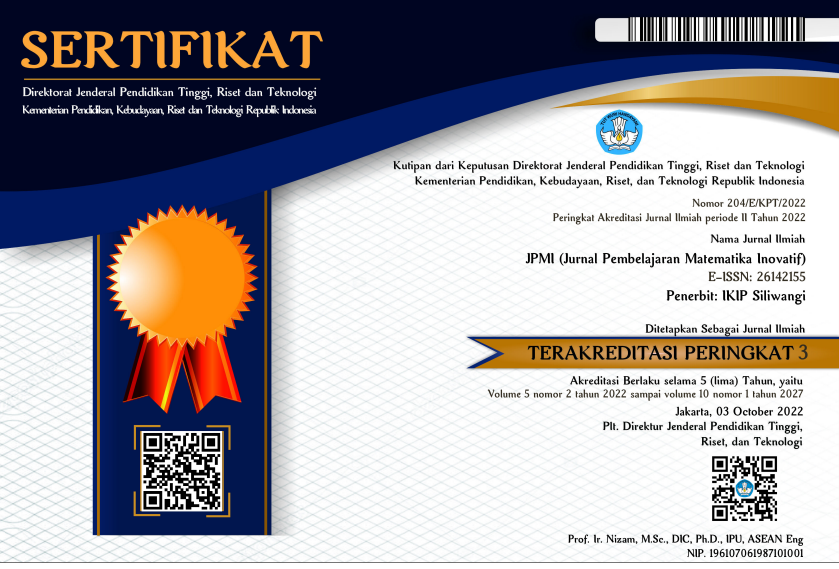ANALISIS KEMAMPUAN PEMECAHAN MASALAH MATEMATIKA DAN DISPOSISI MATEMATIKA SISWA PADA MATERI SPLDV
DOI:
https://doi.org/10.22460/jpmi.v3i2.p%25pKeywords:
, Mathematical Problem solving, Mathematical Disposition, SPLDVAbstract
In this study the authors analyzed the difficulties of students in the process of mathematical problem solving skills and to determine the disposition of students on each item statement. Based on the analysis, for SPLDV material the mistakes made by students in working on mathematical problem solving problems lie in the indicators of understanding the problem only reaching 34% and the average percentage of students' mathematical problem solving abilities in the category instruments. The instrument used is a question that has been tested for reliability, validity , different power and difficulty indexes have also been validated by expert validators. The mathematical disposition of junior high school students is only 65% of the SPLDV material. Indicators of student interest and reflection in learning get the smallest percentage, which is 61%, thus influencing other indicators. The research method uses descriptive qualitative analysis to find out in depth the achievement of indicators of problem solving abilities and mathematical dispositions on each item statement. Based on the results of the overall research that the achievement of indicators of problem solving abilities and student dispositions is high.
References
Aisyah, P. N., Yuliani, A., & Rohaeti, E. E. (2018). Analisis Kemampuan Pemecahan Masalah Matematis Siswa Smp Pada Materi Segiempat Dan Segitiga. JPMI (Jurnal Pembelajaran Matematika Inovatif), 1(5), 1025–1036.
Aripin, U. (2015). Meningkatkan Kemampuan Pemahaman Matematik Siswa Smp Melalui Pendekatan Pembelajaran Berbasis Masalah. P2M STKIP Siliwangi, 2(1), 120. https://doi.org/10.22460/p2m.v2i1p120-127.171
Aripin, U., & Purwasih, R. (2017). Penerapan Pembelajaran Berbasis Alternative Solutions Worksheet Untuk Meningkatkan Kemampuan Berpikir Kreatif. AKSIOMA: Jurnal Program Studi Pendidikan Matematika, 6(2), 225. https://doi.org/10.24127/ajpm.v6i2.989
Cahyani, H., & Setyawati, R. W. (2016). Pentingnya peningkatan kemampuan pemecahan masalah melalui PBL untuk mempersiapkan generasi unggul menghadapi MEA. PRISMA, Prosiding Seminar Nasional Matematika, 151–160.
Dunn, A. M., Hofmann, O. S., Waters, B., & Witchel, E. (2011). Cloaking malware with the trusted platform module. Proceedings of the 20th USENIX Security Symposium, pp. 395–410.
Hendriana, H. (2017). Teachers’ hard and soft skills in innovative teaching of mathematics. World Transactions on Engineering and Technology Education, 15(2), 145–150.
Hidayat, W., & Sariningsih, R. (2018). Kemampuan Pemecahan Masalah Matematis dan Adversity Quotient Siswa SMP Melalui Pembelajaran Open Ended. JNPM (Jurnal Nasional Pendidikan Matematika), 2(1), 109–118.
Lestari, K. E., & Yudhanegara, M. R. (2015). Penelitian pendidikan matematika. Bandung: PT Refika Aditama.
Mahmudi, A. (2010). Tinjauan asosiasi antara kemampuan pemecahan masalah matematis dan disposisi matematis. Makalah Disajikan Pada Seminar Nasional Pendidikan Matematika FMIPA UNY, 17.
Marlina, L. (2011). Penerapan Langkah Polya Dalam Menyelesaikan Soal Cerita Keliling dan Luas Persegi Panjang. Jurnal Elektronik Pendidikan Matematika Tadulako, 1(1), 2013.
Sukayasa, S. (2012). Pengembangan Model Pembelajaran Berbasis Fase-Fase Polya untuk Meningkatkan Kompetensi Penalaran Siswa SMP dalam Memecahkan Masalah Matematika. AKSIOMA: Jurnal Pendidikan Matematika, 1(1).
Webb, N. L. (1979). Processes, conceptual knowledge, and mathematical problem-solving ability. Journal for Research in Mathematics Education, 83–93.
Widodo, S. A., & Sujadi, A. A. (2015). Analisis kesalahan mahasiswa dalam memecahkan masalah trigonometri. SOSIOHUMANIORA: Jurnal Ilmiah Ilmu Sosial Dan Humaniora, 1(1).
Yazgan, Y. (2015). Sixth graders and non-routine problems: Which strategies are decisive for success. Educational Research and Reviews, 10(13), 1807–1816.

















